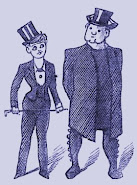It is interesting, and a well-known aspect of the Birth of the Comics, that commercialism played a major role. Comics were weapons in circulation wars between publishers. They received boosts -- creative freedom, vast publicity, and cartoonists treated like stars -- to assist in their acceptance by the public.
The "wars" also featured cartoonists themselves as weapons, objectives, prizes, and goals. many of the great early artists of the Funny Pages switched employers and venues, sometimes dissatisfied with their employers (we have documented that Block seriously annoyed numerous of his cartoonists to the point of their quitting Hearst)... but usually having their services bid and outbid by hungry publishers.
There is a story -- if not true it virtually encapsulates the truth of the times -- that T E Powers spent an afternoon in a Park Row bar, not working for Joseph Pulitzer of the New York World nor William Randolph Hearst of the Journal, but receiving reports from office boys how his salary was going up and up as the two publishers bid against each other for his services. (Hearst won out.)
Frederick Burr Opper drew for the New York Herald (and Puck Magazine) until purloined by Hearst. Rudolph Dirks was hired away from Hearst by Pulitzer; so was Bud Fisher with the assistance of syndicate pioneer John Wheeler. Winsor McCay drew for James Gordon Bennett's two newspapers before Hearst hired him away. George Herriman drew for the World but eventually settled in the Hearst stable. R F Outcault, whose Yellow Kid can be cited for inaugurating this crazy transmigration, worked for Pulitzer, then Hearst, then Pulitzer again, then the Herald, then Hearst until his retirement.
In the eyes of the voracious publishers (benign godfathers they were, when all is said and done; or wet-nurses) there was no bigger star in their constellations than George McManus. He had attracted the attention of Pulitzer in their original working environs of St Louis; then McManus drew for Pulitzer's New York World.
McManus the cartoonist had a short gestation as a struggling stylist; soon his artwork was polished, handsome, mannered... and funny. As a creator, he created multiple strips starring in multiple titles. His premises were funny, and his narratives flowed like stage-plays. In fact his several creations did become Broadway musicals. And his characters appeared on the market as toys and in games.
Probably the most popular of his strips was The Newlyweds, a one-premise strip (as most early comics were) about an obstreperous baby. When McManus switched to Hearst he continued the strip but renamed it Their Only Child!, finessing a sticking-point of other mutinies like Mutt and Jeff and The Katzenjammer Kids whose titles became bones of contention.
McManus created another strip for Hearst, a Sunday page called The Whole Bloomin' Family. It is curious to note that Bringing Up Father, which commenced full-term as a Hearst feature in 1913, never was a Sunday page until six years later. After that it became the major strip among Hearst and King Features' properties for years. It owned the front pages of the Hearst chain's Sunday comic sections until supplanted by Blondie in the early 1950s.
In the 1917 promotion book, McManus was allowed to illustrate the stars in his galaxy including characters he had created, and left, at Pulitzer's shop. We see the eponymous star of Let George Do It; Rosie and her Beau; and Panhandle Pete. In addition, Snookums Newlywed and his parents; the Whole Bloomin' Family; and Jiggs and Maggie of Bringing Up Father.
By the way, and speaking of the Newlyweds and their only child (italics aside), we have a reprint book of daily strips from the New York World. It is from 1907. The strips appeared earlier in the year in the newspaper, not to mention the book collection -- which challenges the convention histories citing Mr A Mutt as the medium first daily strip (November 1907). More to follow in Yesterday's Papers and in the revival of nemo magazine...














No comments:
Post a Comment